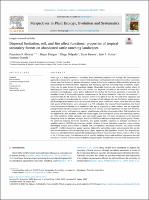Mostrar el registro sencillo del ítem
Dispersal limitation, soil, and fire affect functional properties of tropical secondary forests on abandoned cattle ranching landscapes
| dc.contributor.author | Álvarez, Francisco S | |
| dc.contributor.author | Finegan, Bryan | |
| dc.contributor.author | Delgado, Diego | |
| dc.contributor.author | Ramos, Zayra | |
| dc.contributor.author | Utrera, Luis P | |
| dc.contributor.author | Granda, Vanessa | |
| dc.date.accessioned | 2022-01-28T19:37:02Z | |
| dc.date.available | 2022-01-28T19:37:02Z | |
| dc.date.issued | 2021 | |
| dc.identifier.uri | https://repositorio.catie.ac.cr/handle/11554/11538 | |
| dc.description.abstract | Forest age is a major predictor of secondary forest functional properties and through the chronosequence approach continues to be a principal focus in local, landscape, and regional-scale studies of secondary succession. Recent work has shown that patterns of temporal change in functional properties differ markedly between wet and seasonally dry lowland forests, suggesting that decreasing light and increasing water availability, respectively, are the main drivers of successional change. Meanwhile, however, the potentially marked effects of anthropogenic factors (especially fire), soils, climate, and dispersal limitation on the variation of forest characteristics over landscapes remain poorly understood. We studied the functional properties of seasonally dry secondary forests 5–35 years after pasture abandonment on the Nicoya Peninsula, Costa Rica. We measured 11 functional traits for 63 dominant tree and palm species in 52 plots of 0.12 ha. We used linear regression and variation partitioning to determine the relative importance of soil, climate, site use, fire history, spatial factors, and forest age in the determination of community weighted mean (CWM) trait values. CWM leaf trait and stem trait spectra of the 52 plots were orthogonal in a PCA ordination. Our seasonal forest hypothesis, that forest functional properties become more acquisitive with age as suggested by other authors, was not supported, perhaps because our chronosequence was relatively short. Our fire tolerance hypothesis was that bark thickness, wood specific gravity and resprouting capacity would increase with time of exposure to fires. This hypothesis was not supported for bark thickness. Rather, our results suggest that wood specific gravity and resprouting capacity are better predictors of fire tolerance. Also, our results suggest that >10 years of exposure to fire generates changes in forest fire tolerance strategies from high CWM bark thickness to high wood specific gravity. Finally, we tested our dispersal limitation hypothesis, that spatial variables, expressed as principal coordinates of neighbor matrices (PCNM) eigenfunctions, predict variation in forest functional properties, using variation partitioning analysis with matrices of climate, soil, anthropogenic and spatial variables. The results (overall model R2 = 0.46) indicated that spatial variables, followed by soil (acidity, depth, and extractable Mn), are the best overall predictors of forest functional traits values, supporting this hypothesis. Overall, fire, dispersal limitation and soil characteristics explain the functional properties of these secondary forests, with no effect of age in the 5–35 years range. This indicates a critical need for sampling designs and analytical approaches that take into account all these factors to advance understanding of tropical seasonal forest recovery at the landscape scale. | es_ES |
| dc.format.extent | 10 páginas | es_ES |
| dc.language.iso | en | es_ES |
| dc.relation.ispartof | Perspectives in Plant Ecology, Evolution and Systematics, 52 | es_ES |
| dc.relation.uri | https://doi.org/10.1016/j.ppees.2021.125632 | es_ES |
| dc.subject | DISPERSIÓN | es_ES |
| dc.subject | SUELO | es_ES |
| dc.subject | BOSQUE SECUNDARIO | es_ES |
| dc.subject | SUCESIÓN SECUNDARIA | es_ES |
| dc.subject | CLIMA | es_ES |
| dc.subject | ÁRBOLES | es_ES |
| dc.subject | INCENDIOS | es_ES |
| dc.subject | CORTEZA | es_ES |
| dc.subject | MADERA | es_ES |
| dc.subject | COSTA RICA | es_ES |
| dc.subject.other | Sede Central | es_ES |
| dc.title | Dispersal limitation, soil, and fire affect functional properties of tropical secondary forests on abandoned cattle ranching landscapes | es_ES |
| dc.type | Artículo | es_ES |
| dc.creator.id | Francisco S. Álvarez https://orcid.org/ 0000-0002-4018-775X | es_ES |
| dc.creator.id | Bryan Finegan https://orcid.org/ 0000-0002-7035-255X | es_ES |
| dc.creator.id | Diego Delgado https://orcid.org/ 0000-0002-3346-2178 | es_ES |
| dc.creator.id | Luis P. Utrera https://orcid.org/ 0000-0002-2658-7781 | es_ES |
| dc.identifier.status | openAccess | es_ES |
| dc.subject.sdg | ODS 13 - Acción por el clima | es_ES |


